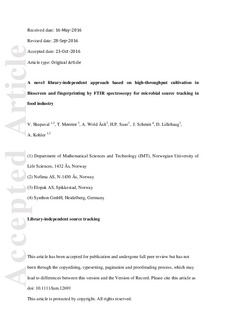| dc.description.abstract | Microbiological source tracking (MST) for food industry is a rapid growing area of research and technology development. In this paper, a new library-independent approach for MST is presented. It is based on a high-throughput liquid microcultivation and FTIR spectroscopy. In this approach, FTIR spectra obtained from micro-organisms isolated along the production line and a product are compared to each other. We tested and evaluated the new source tracking approach by simulating a source tracking situation. In this simulation study, a selection of 20 spoilage mould strains from a total of six genera (Alternaria, Aspergillus, Mucor, Paecilomyces, Peyronellaea and Phoma) was used. The simulation of the source tracking situation showed that 80–100% of the sources could be correctly identified with respect to genus/species level. When performing source tracking simulations, the FTIR identification diverged for Phoma glomerata strain in the reference collection. When reidentifying the strain by sequencing, it turned out that the strain was a Peyronellaea arachidicola. The obtained results demonstrated that the proposed approach is a versatile tool for identifying sources of microbial contamination. Thus, it has a high potential for routine control in the food industry due to low costs and analysis time. Significance and Impact of the Study The source tracking of fungal contamination in the food industry is an important aspect of food safety. Currently, all available methods are time consuming and require the use of a reference library that may limit the accuracy of the identification. In this study, we report for the first time, a library-independent FTIR spectroscopic approach for MST of fungal contamination along the food production line. It combines high-throughput microcultivation and FTIR spectroscopy and is specific on the genus and species level. Therefore, such an approach possesses great importance for food safety control in food industry. | |
